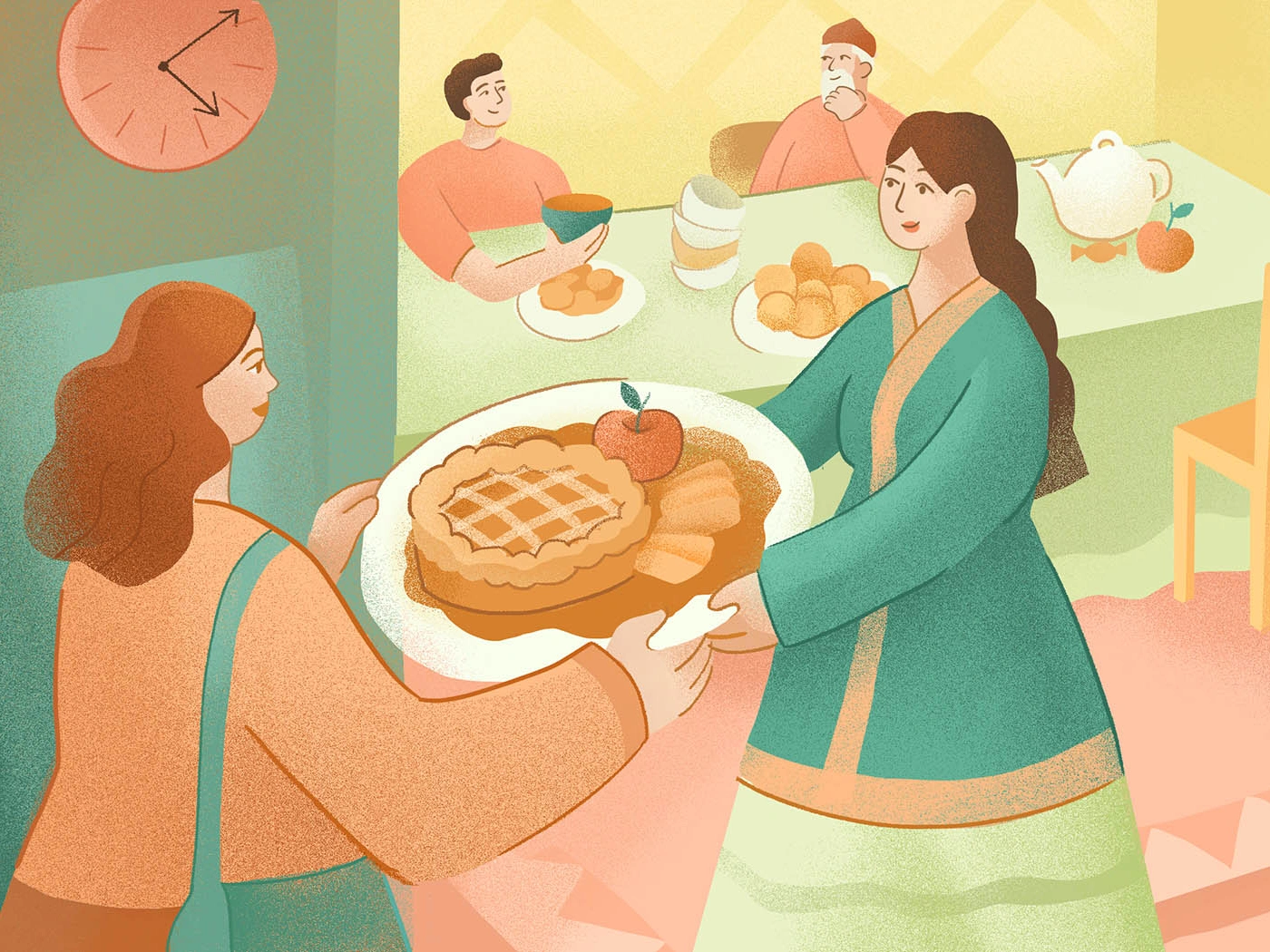
Gifts, meat and tea: a guide on how to visit a Kazakhstani household like a local
Visiting and having visitors are crucial parts of Kazakh culture, roots of which go deep into the history of the nation. Ancient customs and traditions are centred around the act of hospitality, and even in the modern world people carry on this knowledge and act upon it. If you are invited to the Kazakhstani household, you might be tempted to learn what to expect from this visit. In this article, we discuss unique aspects of visiting Kazakhs: from modern etiquette to old traditions.
Welcoming gifts and a sense of time
Guest etiquette starts even before the guest arrives at the house. Welcoming gifts are common to a lot of different cultures, but in Kazakhstan, gostincy (гостинцы, Russian for “welcoming gifts”) should be a sweet treat like chocolate, candies or even a home-made pastry. This gift always feels like an “expected surprise”: guests often bring sweets, but hosts act all surprised and assure visitors that there is no need and they already had a lot at home. Although indeed, there are candies at home, it is still a nice gesture to bring treats. In more informal gatherings, it is possible to ask hosts if they need something, so guests could just bring the missing drinks or candies. If hosts insist that they do not need anything, visitors still bring something small and symbolic for the table.
There is a special guest etiquette about arrival like in any other culture. It is helpful to know that an invitation usually provides information only about approximate time rather than a fixed set hour. One of the peculiar details about Kazakhstani people is their sense of time. As the start time of the event is not fixed, events rarely start on time: rather, everyone is expected to arrive within (hopefully) an hour after. When it comes to small gatherings, it is also practised to start a bit later than the agreed time. The rule of thumb is to arrive no later than 15 minutes. This period is considered to be enough for the host to make the last preparations and for a guest to look casual and fashionably late.
Before gostincy are given, a proper greeting must take place. In Kazakhstan, handshakes between male acquaintances are similar to the ones practised in Muslim countries: men typically do it with both hands, slightly leaning in and nodding. With closer friends, of course, this practice is different: handshakes gradually transform into hugs, which happens both between men and women. Greetings between women often include hugs or kissing on one cheek.
After handshakes and hugs are done, and treats are given, guests move to the dining room and sit at the table. But before going further down the hallway, they should take off their coats and shoes. In Kazakhstan, people prefer being at home in socks or in slippers. Wearing outside shoes inside the house is very uncommon, as they get very dusty and dirty in the street. Usually, households have extra slippers for guests, but floors are normally warm enough to walk just in socks.
Table etiquette and assigned seating
Table etiquette is even a more complicated issue since there are even more important traditions to follow. One of the common customs is assigned seating: it is an unspoken allocation, so it could be a bit tricky. If there is only one guest, he sits at the head of the table: the most important place for a deeply respected visitor. If there are several guests though, this seat is given to the most important guest, which is often an elder or a person in a higher position. Typically, hosts gently ask the guest to take that spot before everyone sits down.
After most or all of the guests arrive, dinner officially starts. Often hosts first serve various appetizers and salads. People at the table generally take care of each other by filling glasses and plates. After some small-time into the evening, the hot dish is served. The honour of the first bite always goes to the “chief” guest: everybody waits until the oldest guest starts eating. This rule is centuries old and is meant to show the deepest respect to the visitor. After the guest at the head of the table has a full plate, hosts fill other visitors’ plates.
In ancient times, cutting and serving mutton meat, especially the head, had strict rules. Usually, the oldest guest had the honour to cut the head: there was even an unspoken rule that a person, whose father was alive, was not supposed to take this role. It was also this guest who distributed the meat to others at the table with wise words and wishes. For example, the throat part signified singing talents, while the liver was meant to show close brotherly-like relationships as bauyr means both liver and brother in Kazakh. Nowadays, this ritual is still respected and practised but mostly occurs at big gatherings like birthdays or weddings.
Closer to the end of the gathering, another ceremony starts: drinking tea. British people have tea at 5 pm, while people from Kazakhstan have tea every hour. A great variety of tea is usually available: green, black, fruity, herbal. Hot drinks are served in normal cups or in Kazakh pialas. Piala is a traditional small bowl used only for drinks. Although they are rarely used at small gatherings, a tradition that is associated with pialas is still quite common: when hosts are pouring tea into the guests’ cups, they do not fill them entirely. This is a sign of deep respect, and it shows the visitor that the host is willing to make another tea and fill that cup again.
During tea-time, the table is never empty. The table is packed with different sweet treats and snacks for guests to enjoy with delicious tea. Often, gostincy from the guests are also served.
Farewell and gifts to guests
Leaving the house is quite a long process. As all of the people were greeted at the beginning of the gathering, they must be treated the same way again upon departing. Farewell is a lengthy process, as other guests often try to finish conversations and make plans before the departing visitor leaves. Meanwhile, hosts make sarqyt for the leaving guest.
Sarqyt is similar to gostincy, but now it is the host who gives it to the guest. While the gift from the guest is always something sweet, sarqyt could be anything from the table: a piece of cake, candies, some meat, salad. It is almost impossible to refuse this treat, as hosts could get slightly offended, so guests just take it with them.
The evening is over, other guests also start slowly heading out. Visiting people could be a bit tiring, but at the same time, nothing can describe how delightful it is to submerge into the ordinary local life and culture. Of course, it is always possible to ask hosts in more detail about the traditions, but impressing them with the prior knowledge of local etiquette is a completely different story.





